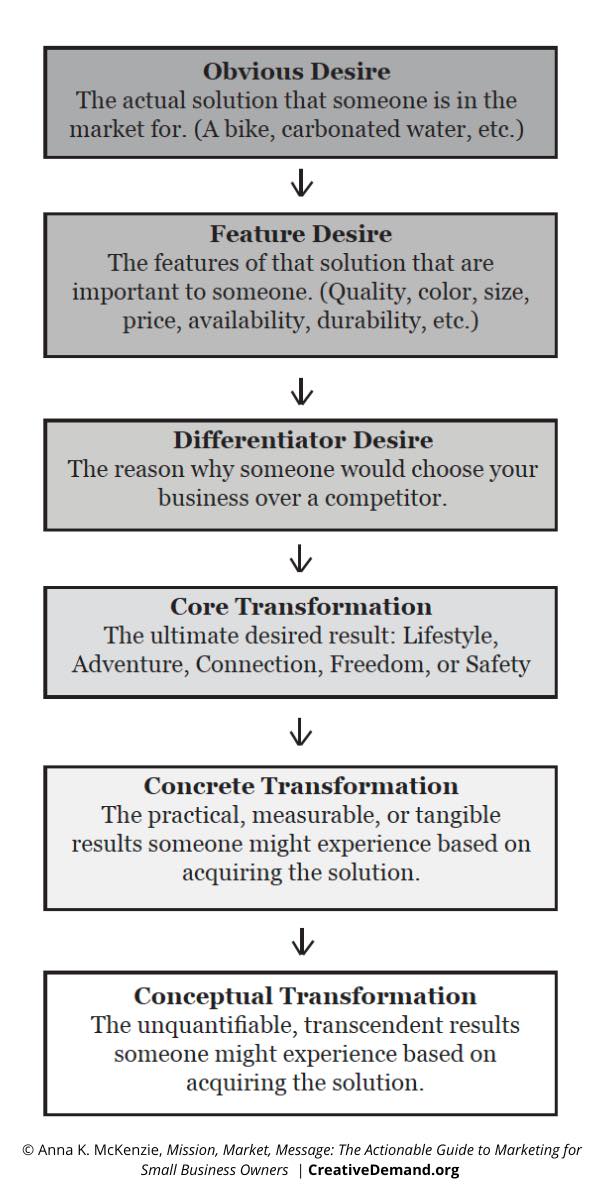The 5 Core Transformations: Understanding What Your Customers Really Want

You might say you’re selling…
- Physical products
- Digital products
- Software as a service (SaaS)
- Client services
… and you would be wrong.
These are the 5 Core Transformations, which represent what everyone is actually selling:
- Lifestyle. Products fit into the context of our lives, and they tell a story about who we are and how we live. Your product is associated with a way of living that conforms to a particular set of values. (Remember, marketing is when you create a connection with a customer by sharing those values.)
- Adventure. We all want to be inspired and have unique, exciting, and enjoyable experiences. Your product offers a certain type of experience that adds value to a person’s livelihood.
- Connection. We seek a sense of belonging and want to be connected to others. Products can make us part of communities or offer ways for us to connect with those around us.
- Freedom. We want freedom TO do things as much as we want freedom FROM other things. Your product provides possibilities, options, a sense of agency, or a measure of ability to start doing some things and stop doing other things.
- Safety. While safety could be considered “freedom from risk,” it deserves its own category. Your product allows customers to avoid certain negative situations or consequences that threaten what they hold dear.
These 5 Core Transformations encompass what people really want when they purchase something — the “thing beyond the thing.” Your potential customers can be seeking multiple Core Transformations — people often do. But your goal is to focus on the one or two they want the most.
For instance, the Walt Disney Company knows they’re selling Adventure, not movies, merchandise, or rollercoaster rides. Even though an excursion to its theme parks can be quite expensive, there’s a reason why Disney World hosts over 58 million visitors a year — making it the most visited vacation resort in the world.1
Core Transformations can be broken down into two parts, concrete and conceptual.
- Concrete Transformations are tangible, measurable, and quantifiable.
- Conceptual Transformations are intangible and transcendent – essentially, the feeling or effect that someone experiences.
Here’s an example: It can be said that the Core Transformation for Walmart is Freedom. By offering lots of products at low prices, Walmart is providing customers the freedom to live the kind of lives they want. This is indicated in their slogan, which combines a Concrete Transformation with a Conceptual Transformation: Save Money, Live Better.

Core Transformations contain both the Concrete and Conceptual. Even though the Conceptual is more powerful, Concrete Transformations are often used to precede them, bridging the gap in a measurable, practical way.
When you realize that you’re really selling transformations, you can connect with your potential customers on a completely different level.
Here’s another example: When James Freeman founded Blue Bottle Coffee, he knew that there were plenty of coffee giants to contend with — especially Peet’s and Starbucks. And while his goal was to introduce different tastes to the coffee crowd, he also wanted to make Blue Bottle experientially different, from the space to the service, hospitality, and brews.2
Thanks in part to its clean, minimalistic aesthetic, Blue Bottle Coffee became both distinct and attractive to customers.
Freeman knew he wasn’t selling coffee, but a Lifestyle of margin and beauty. Customers came to fulfill their coffee routine and perhaps to socialize, work, or study (the Concrete Transformation), but the draw was in the Conceptual Transformation (the feeling of peace and relaxation), which came through in Blue Bottle’s pared-down, refreshing style.
Concrete and Conceptual Transformations are part of the Desire Chain.
Understanding the Desire Chain is key to the development of all your messaging. When your messaging is fully tuned in, your customers can connect with your brand and convert.
The Desire Chain: How to Break Down Your Customers’ Desires
The Desire Chain helps you break down your customers’ desires so you know what’s most valuable to them.

The Desire Chain is full of different types of desires that may compel customers to buy. Our wants are less like blinking red lights than they are like tangled, glowing knots. We might say we want something for a certain reason and then buy it for a completely different reason.
Now that you know what the Desire Chain looks like, here’s how to use it in your marketing.
This is an edited excerpt from my book Mission, Market, Message: The Actionable Guide to Marketing for Small Business Owners, which you can purchase on Amazon.
Sources:
1. Disney World Statistics - The Truly Fascinating Numbers Behind Disney. Magic Guides. (2020, May 11). https://magic-guides.com/disney-world-statistics/.
2. Benton, D. (2020, May 22). Blue Bottle Founder James Freeman’s Journey From Mozart to Cortados. Adobe 99U. https://99u.adobe.com/articles/59614/blue-bottle-founder-james-freemans-journey-from-mozart-to-cortados.
